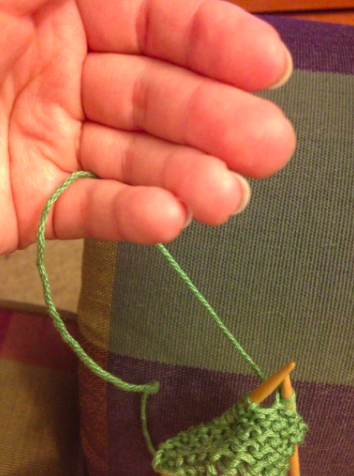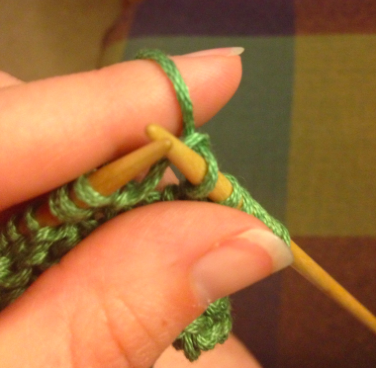After learning about all the different knitting techniques used throughout the world (like the Russian knitting technique, the Japanese knitting technique, and the Armenian knitting technique) are you beginning to be a little confused, wondering just how many ways there could possibly be to hold your yarn and work a knit stitch? Well, let’s take the confusion out of one of them: German knitting.
German knitting is just another name for Continental knitting. There is some evidence that this particular knitting style originated in Germany, hence it often being referred to as German knitting.
German knitting is all about how you hold the yarn. For German knitting, you hold the working yarn in your left hand. Start by wrapping the yarn around the pinkie finger on your left hand. With the yarn end that goes to the yarn ball coming on the palm side of your pinkie finger, then over it between the pinkie and ring finger. Then loop that yarn back under the pinkie finger. Like this:

Next, pick up the yarn with your index finger so that it’s coming over the top of your finger. If you do it right, the yarn will be immediately behind your needle tips. Ideally, as you work your knit stitch, you won’t need to wrap your yarn around the right-hand needle, so much as you’ll flick the tip of that needle to pick up the yarn. Like so:

If you’re having trouble maintaining the tension the way you want it, you can also involve the middle finger on the left hand, letting the yarn go in and out over that finger as well. As always, the only wrong way to do it is the way that doesn’t work for you.
The yarn hold remains the same on the purl stitch, though there is more of a yarn wrap on that stitch. The yarn should still be close to the needle, and you should still use more of a repositioning of your hands to achieve the wrap.
The main purpose of the German knitting hold is to be efficient with the movement, which seems fitting. (I can say that because I’m part German and my German great-grandmother was the queen of no-nonsense efficiency!) Also, it does put less stress on the wrists.
I will confess, though, that I did not inherit that trait from her. I am an English knitter and have all kinds of trouble making German knitting work for me. The key seems to be in maintaining the proper yarn tension as it loops around the fingers on the left-hand, but I have not figured out how to make that tension remain consistent as I work through my stitches.
The purl stitch is also a bit of an exercise in faith. Getting the new yarn loop to stay on the right-hand needle as you pull it back through the stitch can be tricky. To get more practice with basic knitting techniques, you might enjoy Stefanie Japel’s online Craftsy class Knit Lab!
Come back to the Craftsy blog tomorrow to learn thumb method cast-on knitting.

Share tips, start a discussion or ask one of our experts or other students a question.
No Responses to “Have You Heard About the German Knitting Technique?”